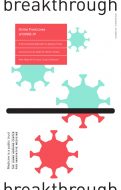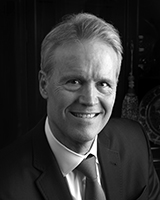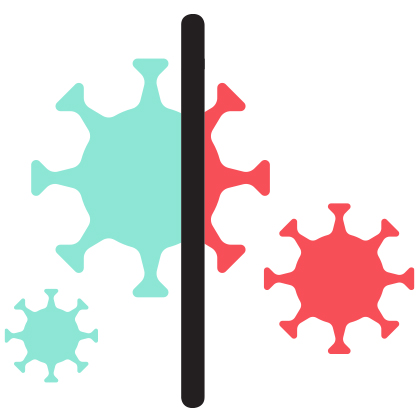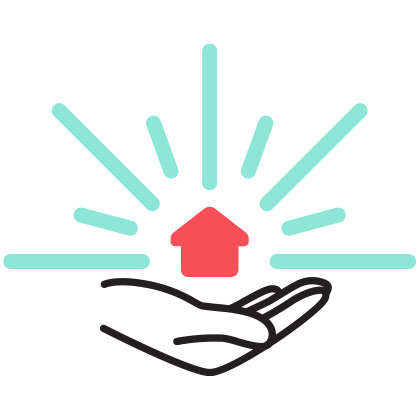

David B. Hellmann,
MD, MACP
When we first began work on this issue of CIM Breakthrough, COVID-19’s explosive spread in China had just begun to gain the world’s attention. What a difference a few months can make. As I write this today, the Coronavirus has become a scourge around the globe. In the face of fear and uncertainty, it’s been incredibly heartening to watch as our clinicians and scientists across Johns Hopkins Medicine have mobilized to meet the expected surge in COVID-19 patients at our hospitals, and to pursue new protocols and treatments to stem the immense suffering caused by this global pandemic (see p. 2).
The courage that all have shown, with so many putting their own lives at risk to respond so selflessly, offers concrete reality to “Medicine is a Public Trust,” the pillar of our work here at the Center for Innovative Medicine. In the words of Suzanne Koven, a former Osler resident and now a Harvard faculty member working at Massachusetts General: “They Call Us and We Go.” That is the aptly titled commentary she authored recently in The New England Journal of Medicine, which explores how and why doctors during this COVID-19 crisis are living into their promise to never turn away from human suffering.
Clearly, the world is grateful, as evidenced by those quarantined people who come out to their balconies at night, from Manhattan to Milan, to sing their thankfulness. Their turning to music to find beauty and hope in the midst of crisis resonates with the focus of my 2020 Miller Lecture in May – “Bayview: Johns Hopkins’ Ode to Joy” – which explores one of my favorite pieces of music, Beethoven’s Ninth Symphony. There is a rousing melody in the 4th movement that is played first by the cello, then the viola, then the violin, before the entire orchestra comes in to play it together. It’s a beautiful metaphor for the promise of medicine. I imagine Beethoven first contemplating what the promise of medicine could be with the cello line of “caring.” Then how much grander medicine could be by adding the viola of “science.” Then he ponders how much more boldly the promise of medicine could be proclaimed by adding a third strand: justice related to health. Finally, Beethoven does what every great academic medical center should aspire to do: He puts it all together.
To me, Beethoven’s Ninth Symphony really is a musical version of medicine as a public trust. In this time of global pandemic, it is an inspiration to all of us that harmoniously weaving together all three strands in academic medicine — caring, science and justice related to health – gives us the potential to achieve greatness in a way that any one strand cannot achieve on its own.

Aliki Perroti Professor of Medicine;
Vice Dean, Johns Hopkins Bayview Medical Center;
Chairman, Department of Medicine
Don Willett May 31st, 2020
Posted In:

David B. Hellmann,
MD, MACP
When we first began work on this issue of CIM Breakthrough, COVID-19’s explosive spread in China had just begun to gain the world’s attention. What a difference a few months can make. As I write this today, the Coronavirus has become a scourge around the globe. In the face of fear and uncertainty, it’s been incredibly heartening to watch as our clinicians and scientists across Johns Hopkins Medicine have mobilized to meet the expected surge in COVID-19 patients at our hospitals, and to pursue new protocols and treatments to stem the immense suffering caused by this global pandemic (see p. 2).
The courage that all have shown, with so many putting their own lives at risk to respond so selflessly, offers concrete reality to “Medicine is a Public Trust,” the pillar of our work here at the Center for Innovative Medicine. In the words of Suzanne Koven, a former Osler resident and now a Harvard faculty member working at Massachusetts General: “They Call Us and We Go.” That is the aptly titled commentary she authored recently in The New England Journal of Medicine, which explores how and why doctors during this COVID-19 crisis are living into their promise to never turn away from human suffering.
Clearly, the world is grateful, as evidenced by those quarantined people who come out to their balconies at night, from Manhattan to Milan, to sing their thankfulness. Their turning to music to find beauty and hope in the midst of crisis resonates with the focus of my 2020 Miller Lecture in May – “Bayview: Johns Hopkins’ Ode to Joy” – which explores one of my favorite pieces of music, Beethoven’s Ninth Symphony. There is a rousing melody in the 4th movement that is played first by the cello, then the viola, then the violin, before the entire orchestra comes in to play it together. It’s a beautiful metaphor for the promise of medicine. I imagine Beethoven first contemplating what the promise of medicine could be with the cello line of “caring.” Then how much grander medicine could be by adding the viola of “science.” Then he ponders how much more boldly the promise of medicine could be proclaimed by adding a third strand: justice related to health. Finally, Beethoven does what every great academic medical center should aspire to do: He puts it all together.
To me, Beethoven’s Ninth Symphony really is a musical version of medicine as a public trust. In this time of global pandemic, it is an inspiration to all of us that harmoniously weaving together all three strands in academic medicine — caring, science and justice related to health – gives us the potential to achieve greatness in a way that any one strand cannot achieve on its own.

Aliki Perroti Professor of Medicine;
Vice Dean, Johns Hopkins Bayview Medical Center;
Chairman, Department of Medicine
Don Willett June 2nd, 2020
Posted In:
 In mid-April, as the number of hospitalized patients with COVID-19 at The Johns Hopkins Hospital and Johns Hopkins Bayview Medical Center continued to grow, we checked in with pulmonologist Brian Garibaldi, director of the newly established COVID-19 Precision Medicine Center of Excellence, to find out about the life-and-death challenges that he and his colleagues are facing each day.
In mid-April, as the number of hospitalized patients with COVID-19 at The Johns Hopkins Hospital and Johns Hopkins Bayview Medical Center continued to grow, we checked in with pulmonologist Brian Garibaldi, director of the newly established COVID-19 Precision Medicine Center of Excellence, to find out about the life-and-death challenges that he and his colleagues are facing each day.
Garibaldi, the Douglas Carroll, MD, CIM Scholar, is also medical director of the Johns Hopkins Biocontainment Unit and associate director of the Osler Medical Residency Training Program. The Q&A that follows is adapted from a podcast produced for “Public Health on Call” at the Johns Hopkins Bloomberg School of Public Health, conducted by interviewer Stephanie Desmon.
Has the onset of the pandemic raised the need for new treatment methods and protocols?
Yes, it’s not very often that you encounter patients who have a completely new disease. Those of us who have been seeing these patients feel an incredible sense of urgency to make sure that we’re not only providing care for these patients, but that we are using the best evidence in terms of different treatment options. We are in touch with our colleagues who are doing both clinical and basic science research to contribute to how we move forward and hopefully positively impact the care provided – across the country and around the world
– throughout the rest of this epidemic.
What’s different about caring for patients who come in with COVID-19?
The patients who are getting very sick are shorter of breath. The normal respiratory rate is somewhere between 12 to 15 times a minute. We’re seeing lots of patients who are breathing in the 20s and even 30s and working very hard to breathe. And that usually corresponds to people who have a need for more oxygen. That’s when we worry about whether they will require care in the ICU and potentially need help breathing with a breathing machine.
“We have to be very proactive in identifying who might need that extra support so that we can get them to the units that can handle them, and get the right providers into their gear to help patients with an urgent need.” – Brian Garibaldi
One of the things that’s different about caring for these patients is that it takes time to get into your personal protective gear and to get into a patient’s room if they’re not doing well. So, we have to be very proactive in identifying who might need that extra support so that we can get them to the units that can handle them, and get the right providers into their gear to help patients with an urgent need.
That has implications for our normal care policies in the hospital, since it takes time to make sure that you are protecting yourself and the rest of the team to be able to respond. We’re hoping that the protocols and monitoring we put into place can help us identify those patients early so that we can really minimize the number of times there is an unexpected emergency where people have to rush into the room – because in this particular climate you can’t do that safely.
Given the need for social distancing and isolation, how has the atmosphere within the hospital changed in recent weeks?
Usually the hospital is a bustling metropolis with thousands of people going about their daily lives, so it’s odd to be walking through the hallways and to just see people who work at the hospital. For us as providers, it’s odd to be in the hospital but to have to socially distance from each other. That whole idea of rounding together, and the community you develop who normally would meet together and huddle – that’s gone. We’ve had to move to virtual communications, either through email or online chat platforms.
Our patients don’t have the physical support networks they normally have, and it certainly has been a different experience for us as providers not being able to meet face-to-face with families. Many of our patients are relying on their smart phones and other ways to keep in touch with friends and family. And we’re doing the same things: relying on phones and sometimes face-timing or using some other ways of connecting with families to keep them on top of what is happening. That’s certainly different from usual, when we walk into a room and say “Hi” to patients’ families and update everyone all together.
One of my big jobs prior to this outbreak was working on teaching clinical skills to our house staff. We had an active initiative to increase the amount of time we spend with patients and their families at the bedside. Obviously, that is not something we can physically do right now. But I think leveraging that energy around the importance of spending time with patients to try to figure out what other things we can put into place to ensure we are spending the time we need – both to make medical decisions but also to make sure our patients are getting what they need from us – I think that’s a huge challenge and lots of great ideas are starting to surface about how we can do that better.
“Our patients don’t have the physical support networks they normally have, and it certainly has been a different experience for us as providers not being able to meet face-to-face with families.” – Brian Garibaldi
The news is abuzz with stories about potential treatments for COVID-19, particularly hydroxychloroquine, a drug used to treat malaria and lupus, which President Trump has repeatedly referred to with great optimism as a cure.
Yes, there’s been a lot of excitement about a number of different potential treatment opportunities.
For me personally, I’ve enrolled myself in a trial of hydroxychloroquine sulfate for post-exposure prophylaxis – this will look at health care providers like me who have treated COVID-19 patients and have been wearing personal protective equipment. The reason I signed up for the study is that I feel like this is my opportunity to really add to the data that we have about that drug and to see if it is safe, and to determine whether it has a role to play.
I hope that it will, but I think that we have to maintain a pretty healthy dose of skepticism right now and resist the urge to give this medicine to everyone. We all want to do something to help our patients, but sometimes doing something can be more harmful than doing nothing, and I think we need to keep that in mind.
Don Willett May 31st, 2020
Posted In:

Sarah Szanton knows that it often doesn’t take much to allow an older person to remain living safely at home, performing daily functional tasks like bathing, dressing, moving around and eating – and that’s become more
important than ever in the COVID-19 era, with millions of the vulnerable elderly being urged to shelter in place to avoid infection.
Sometimes it’s as simple as installing a grab bar in the bathtub, modifying medications and purchasing a sturdy step stool to reach the kitchen shelves. Other times, it might entail fixing the front steps, learning how to conserve physical energy, and installing nonskid mats and better lighting throughout the person’s home.
Each older person’s needs and goals are unique, Szanton notes, but equipped with a budget of $1,300 and the collaborative support of a nurse, an occupational therapist and a handyperson, older people can take the lead in developing and implementing a personalized plan that will allow them to thrive as they “age in place” in the comfort and familiarity of their own homes. That’s the guiding force behind CAPABLE (Community Aging in Place – Advancing Better Lives for Elders), an innovative program that Szanton co-developed a decade ago at Johns Hopkins, with Laura Gitlin, that is now in use at 29 sites in 15 states.
“The power of CAPABLE has to do with listening to what an older person wants to be able to do, and then making the small adaptations to make that possible,” says Szanton, who is director of the Center for Innovative Care in Aging at the Johns Hopkins University School of Nursing.
The results of the program are impressive. A clinical trial published last year showed that participants in the CAPABLE program had a 30 percent drop in disability scores over five months, compared with those who only had social visits from a researcher. Participants also see improvements in symptoms of depression and in participants’ ability to grocery shop and manage their medications, studies show.
The benefits don’t end there. “It turns out that improving these kinds of functional outcomes ends up saving health care costs” by reducing emergency room visits and hospitalizations, and by preventing the need for nursing home care, notes Szanton. “In fact, we’ve been able to show seven times the return on investment,” she says, pointing to studies showing that costs of about $2,825 per participant saved the Medicare program about $22,000 over two years.
“It’s important to think of older adults as a gift, not a burden, and they are a naturally growing resource. We need to do everything we can to help them continue to contribute to society.” – Sarah Szanton
CAPABLE is gaining the attention of policymakers, health care administrators and aging advocates across the country. Last fall, Szanton was honored with a prestigious award from the Heinz Family Foundation, which annually lauds recipients for finding solutions in five critical areas. Szanton’s unrestricted $250,000 prize was awarded in the “human condition” category.
Around the same time, a federal advisory board recommended that CAPABLE be tested as a Medicare payment model, which would vastly expand its reach. Already, CAPABLE can be covered under Medicare Advantage plans, which may offer benefits for some nonmedical services that frequently address what are known as social determinants of health – access to food and transportation, for instance, and the ability to pay for medications. These factors are now known to have a profound impact on patients’ health and to drive as much as 80 percent of health outcomes, according to the Centers for Medicare and Medicaid Services.
“This is the way that health care should have always been done, but with the nation’s fee-for-service model, it wasn’t incentivized,” says Szanton. As health care reform in the United States shifts health care to a value-based care model, which rewards providers for health outcomes and high-quality care, she says, “the financial incentives are being aligned with health in a much more holistic way, and CAPABLE is part of that stream of innovation.”
Adds Szanton: “More and more frequently, health care insurers are coming to us to discuss how CAPABLE could fit into the services they are already providing. We’re also working with Habitat for Humanity, Meals on Wheels and some regional departments of aging.”
The timing for CAPABLE couldn’t be better. With the aging of the baby boom generation, the nation is seeing 10,000 adults turn 65 every day. “It’s important to think of older adults as a gift, not a burden, and they are a naturally growing resource,” says Szanton. “We need to do everything we can to help them continue to contribute to society.”
The home adaptations that CAPABLE team members make possible – like repairing the front steps and adding a handrail, or making the interior easier to negotiate – have allowed participants to get out to volunteer at local schools and to safely care for grandchildren and foster children, she says.
“This is truly personalized medicine,” says Szanton. “We don’t come in with a checklist. And CAPABLE is person directed, not just person centered. The clinician is there only to elicit their goals, to understand what they want. The older adult is in charge. If they drive the goals, then they’re going to be invested in implementing what they come up with.”
Before becoming a nurse practitioner, Szanton worked to help vulnerable people with housing challenges – migrant farm workers and the adult homeless – and then as a lobbyist. “So, I come at this with a real policy bent and am continually asking: How can we frame our efforts for maximal benefit to society?” By saving money on health care costs for the aged, CAPABLE frees up funding to invest in other parts of the health care system and other parts of society, she notes.
Szanton sees supporting function in older adults as nothing short of a moral imperative. “Being functional is foundational to a meaningful life,” she says. “We all want to have control over our lives, and that doesn’t change as we age. Older adults should be able to age with dignity.”
Don Willett May 31st, 2020
Posted In:

In its heyday in the 1950s, Turner Station was a thriving enclave of 10,000 people, nearly all African American, tucked away in the southeastern corner of Baltimore County near Bethlehem Steel.
Today, the community perhaps best known for being the home of Henrietta Lacks – whose cancer cells, harvested at The Johns Hopkins Hospital in 1951, would become the immortal HeLa cell line – has shrunk to about 3,000 residents.
Among those who remain in Turner Station: a vibrant community of African American elders, many of whom have stepped in to help care for their grandchildren because their own children are grappling with substance use disorders and incarceration. Strengthening the intergenerational ties between these two groups while simultaneously addressing the health needs of the elders has been a focus of CIM Scholar Erica Johnson, director of the Internal Medicine Residency Program at Johns Hopkins Bayview Medical Center. And to aid in this important work, Johnson has enlisted the participation of Johns Hopkins Bayview’s internal medicine residents.
“It’s vital for doctors in training to see and understand how the community where our patients live and work shapes their health,” says Johnson, who grew up in Baltimore and completed 11 years as a Medical Corps officer in the U.S. Army, earning a Bronze Star, before joining the faculty at Johns Hopkins.
So, each August and September, as part of the residency program’s Foundations of Clinical Excellence course, she takes interns to tour Turner Station and talk with residents and community leaders there. From these conversations, the Johns Hopkins residents learn just how much social determinants of health – access to healthy food and transportation, education, and income, for example – impact the health outcomes of patients.
Johnson and her colleagues also launched Project Voice, a yearlong project that enlisted the involvement of local Girl Scout troops. Equipped with cameras, the girls set out to interview and photograph Turner Station elders and to capture their personal stories about aging, health and community life.
“We followed up with guided discussions, which included our medical residents, where the girls shared their photos and narratives, and the medical residents shared their perspectives as community-engaged physicians,” says Johnson. “One key theme that emerged was the isolation felt by older adults in the community. Another was that the elders needed to receive better health information in a way that was accessible to them.”
“It’s vital for doctors in training to see and understand how the community where our patients live and work shapes their health.” – Erica Johnson
In response, says Johnson, “our medical residents are now conducting more activities around health-related topics at the Fleming Senior Center,” which is located in the heart of Turner Station. The seniors aren’t the only ones who have benefited from Project Voice. “Our residents have gained a deeper understanding of the impact of chronic disease from the perspective of the elders,” says Johnson, “which has equipped them with new approaches for communicating with elders during clinical encounters.”
Johnson and others have presented findings from Project Voice at the national meeting of the Society of General Internal Medicine, and they have a manuscript in progress that will summarize the project’s scope and findings.
Hand in glove with Johnson’s work in the Turner Station community has come her commitment to improving the rate of underrepresented in medicine (URM) residents in Johns Hopkins Bayview’s internal medicine program. “Increasing the diversity of our medical residents is crucial for so many reasons,” says Johnson. Among those reasons: Physicians from URM backgrounds are more apt to work in minority communities, and patients in those communities report feeling more comfortable with doctors of URM backgrounds, resulting in greater patient satisfaction and better health outcomes.
In 2017, just 9 percent of trainees who signed on to the internal medicine residency at Johns Hopkins identified as URM. To better understand why, Johnson and her colleagues looked closely at the role that unconscious bias (learned stereotypes that are automatic, unintentional and deeply ingrained) could be playing in recruitment efforts.
They subsequently launched new training to recognize and prevent implicit bias in those charged with recruitment. Johnson also led efforts to implement a new, more holistic review model for resident selection, provided by the Association of American Medical Colleges, which “puts more emphasis on important types of experience over typical metrics, such as test scores,” she says.
“We were able to increase our rate of interns who are underrepresented in medicine from 9 percent to 41 percent the first year, and 38 percent the second year. That’s four times the national average for internal medicine residency programs.” – Erica Johnson
The results of these efforts were dramatic. “With those two interventions, we were able to increase our rate of interns who are URM from 9 percent to 41 percent the first year, and 38 percent the second year,” says Johnson. “That’s four times the national average for internal medicine residency programs.”
She adds, “The people we are bringing in are not only more diverse, they are really contributing to the academic environment in an important way and making the entire program stronger.”
In January, Johnson was one of eight people at Johns Hopkins honored with a 2019 Martin Luther King Jr. Award for Community Service. She also recently earned the inaugural Award for Excellence in Inclusion, Diversity, and Equity in Medical Education and Patient Care from the Alpha Omega Alpha Honor Medical Society, and was honored with the 2018 C. Lockard Conley Award.
“Whether treating patients, teaching medical residents or working with community members, Dr. Johnson inspires her trainees to care about patients as people in the context of their life experiences and cultural backgrounds,” noted the selection committee for the Conley Award, which honors the longtime Johns Hopkins hematologist and beloved educator who died in 2010. “If Dr. Conley could have seen the future of medicine, he would have been very pleased that Dr. Erica Johnson is in the forefront of this new wave of physicians and educators.”
Don Willett May 31st, 2020
Posted In: